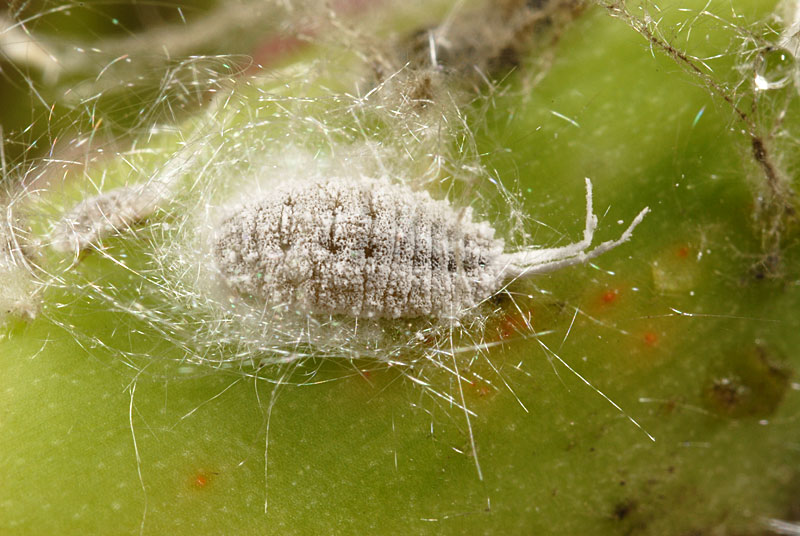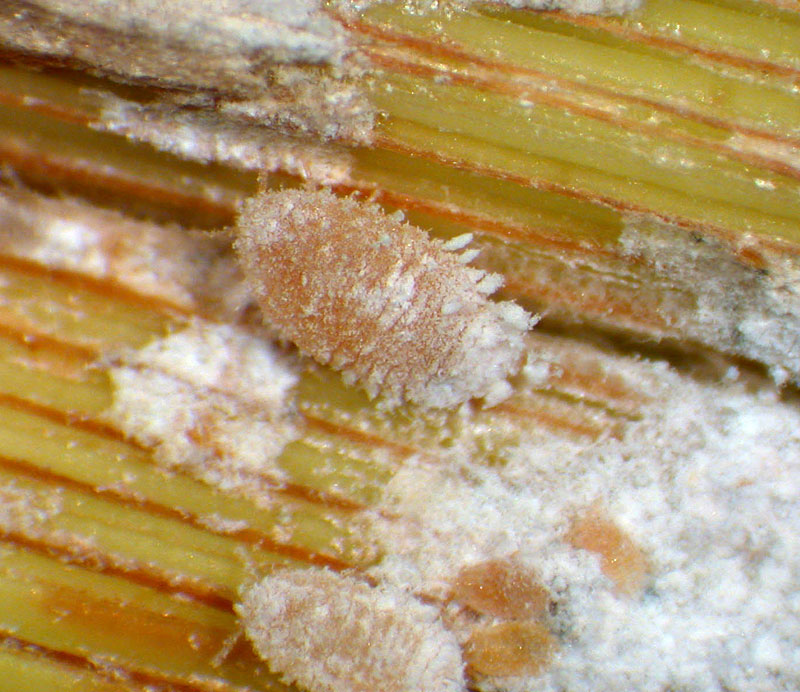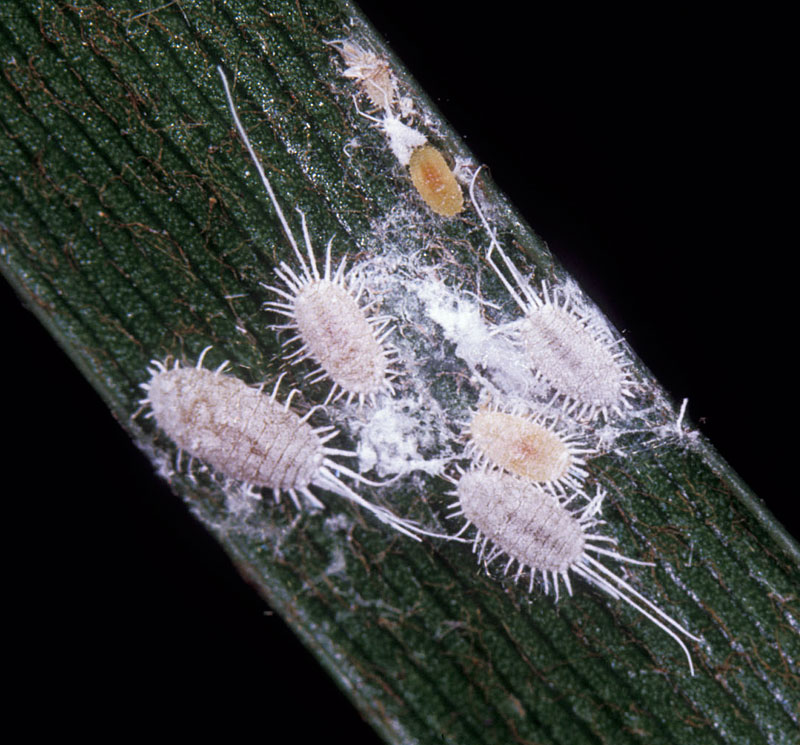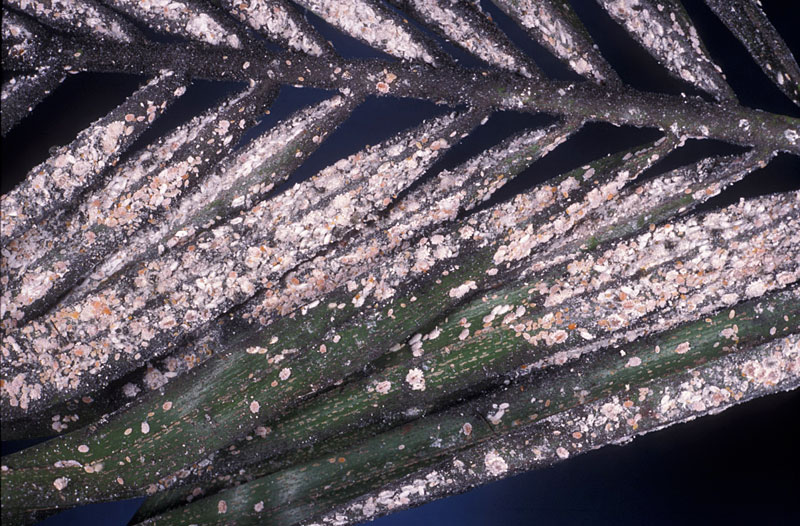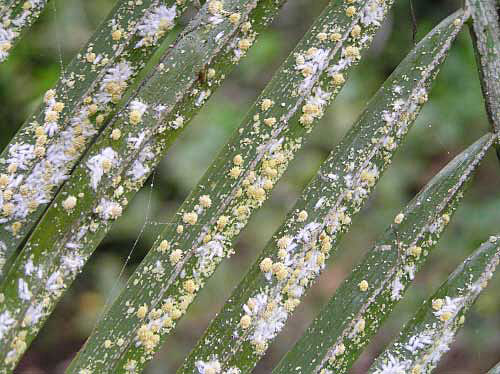Mealybugs
|
striped mealybug, Ferrisia virgata, adult; Photo by Lyle Buss, University of Florida |
|
Palmicultor browni, adult; Photo by Avas Hamon, FDACS-DPI |
|
long-tailed mealybug, Pseudococcus longispinus, adults; Photo by James Castner, University of Florida |
|
coconut mealybug, Nipaecoccus nipae, adults and crawlers; Photo by Lyle Buss, University of Florida |
|
coconut mealybug, Nipaecoccus nipae, infestation on a palm with accompanying sooty mold; Photo by Lyle Buss, University of Florida |
|
coconut mealybug, Nipaecoccus nipae, infestation on pygmy date palm, Phoenix roebelenii; Photo by Scot Nelson and Mike Nago, University of Hawaii at Manoa |
Rank & taxon
Family Pseudococcidae
Description
Adult female mealybugs are around 3-5 mm in length, typically elongate or oval in shape, and are usually covered with a mealy, white, waxy secretion. The color of the body, often pink or yellowish, may show through the wax. The margins of the body often have wax filaments. Mature females have well-developed antennae and functional legs. Mealybugs typically produce an ovisac from their white waxy secretions in which they lay their eggs. Female mealybugs do not undergo a true metamorphosis, so the instars are not easily differentiated other than by size. Males, on the other hand, look similar to the females for the first two instars, then go through a pupal stage, emerging as a winged, short-lived, non-feeding adult.
Distribution
Worldwide; 262 genera, representing nearly 2,000 species
Biology/life cycle
Mealybug females have four instars while males have five. Mealybugs may reproduce parthenogenetically or sexually, depending on the species. Adult females lay eggs or first instars. Eggs are laid in an ovisac made from their waxy secretions, which may enclose all or part the the female's body. The first instarinstar:
stage in an insect's life history between any two molts. The newly hatched insect is the first instar, and the adult (imago) is the final instar.
is known as a crawler and moves about the plant locating a suitable feeding site. Once they settle, they usually remain in that site for the rest of their life. Although all instars have legs in most species, mealybugs are primarily sedentary. Most species have 1 or 2 generations per year, though up to 8 generations per year have been reported under greenhouse conditions.
Hosts
Palms: a wide variety of palms
Other: a wide variety of dicotyledons, occasionally found on other monocotyledons or gymnosperms, and rarely on ferns
Representative taxa on palms
Dysmicoccus is one of the more common genera on palms. Some species within the genus are polyphagous while others are palm specific.
Though native to Oceania and Southeast Asia, Nipaecoccus nipae (coconut mealybug) is a common pest of various palm species in greenhouses and container-grown palms in North America, occuring most commonly on Howea spp.
Pseudococcus longispinus (long-tailed mealybug) is distinguished by the presence of two very long filaments on the caudal end of the body, with two shorter ones to either side. This species is another common pest of ornamentals in greenhouses, including palms.
Additional comments
Mealybugs produce copious amounts of honeydewhoneydew:
the sticky, sweet secretion produced by sap-feeding bugs
, fostering the growth of sooty mold, and they are also frequently tended by ants. Most mealybug species infest leaves and other aboveground plant parts, preferring hidden sites such as folds or crevices. Some species may infest roots as well. Though they have functional legs, they are not particularly active and do not usually appear to respond to disturbances. Definitive species identification in mealybugs is usually based on microscopic characters from a slide-mounted adult female and should be done by an expert.


